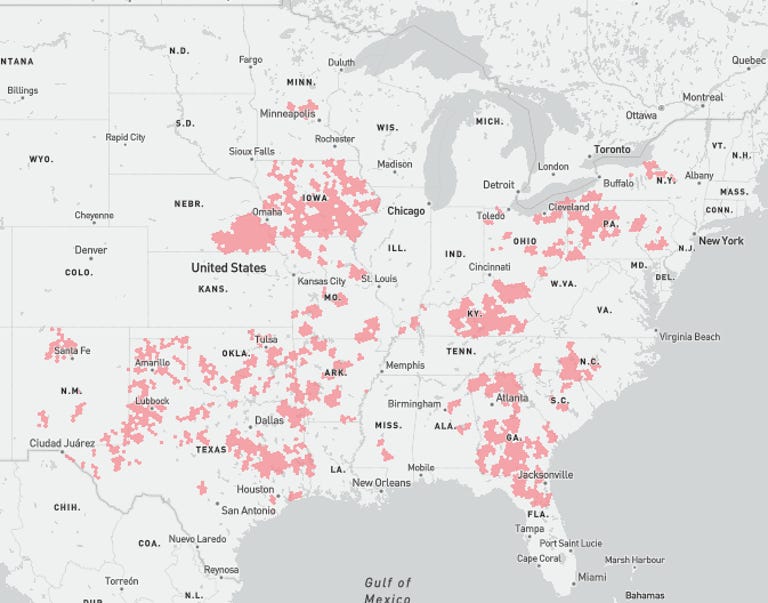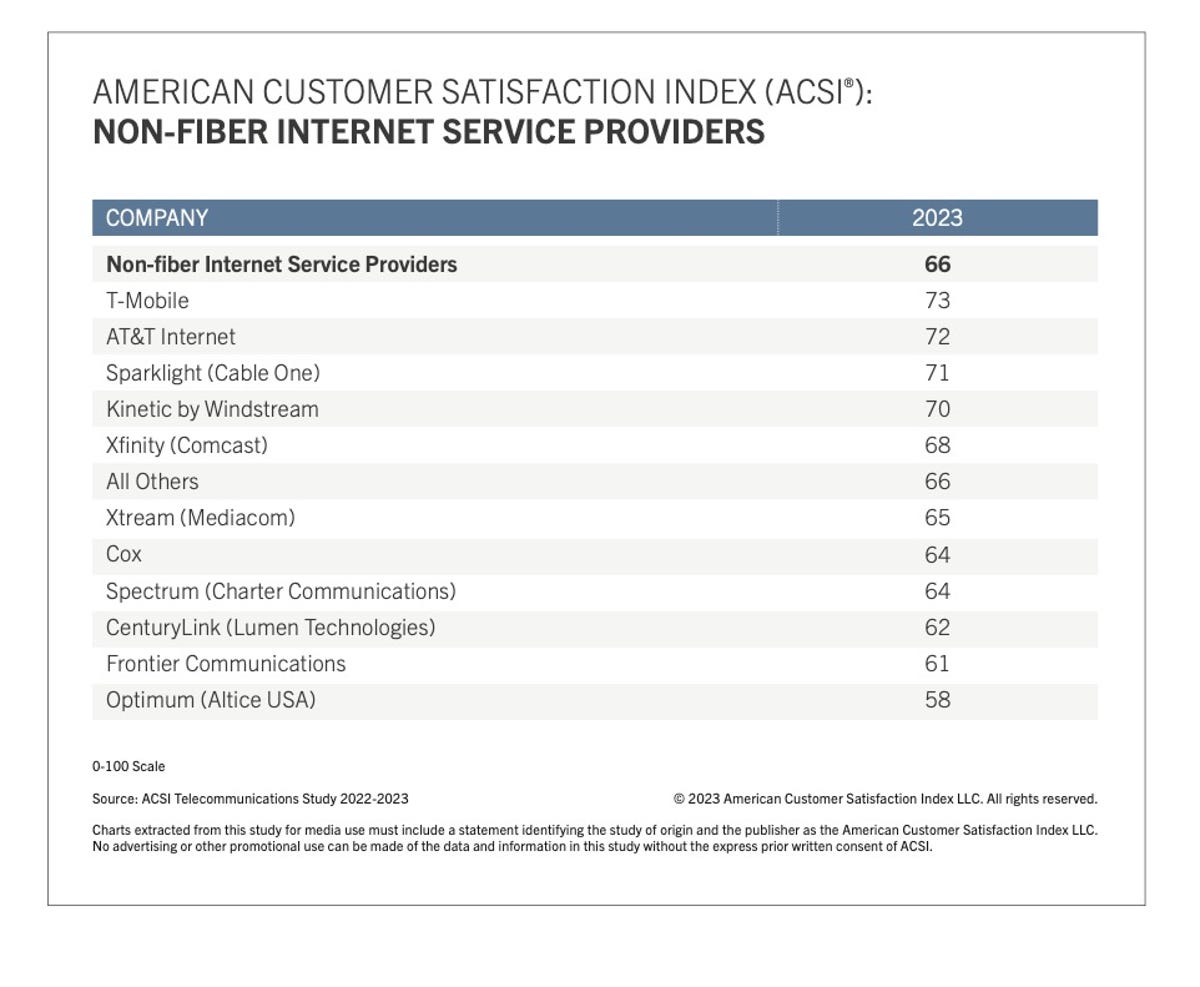Unavailable in Provider unavailable in 90001
Kinetic home internet rating
Pros
- Fast speeds for rural areas
- No data caps, no speed throttling, no contracts
- Fiber expansion in the works
Cons
- Speeds and pricing vary widely by location
- No security plan included
- Below average customer satisfaction
Kinetic (the brand name for Windstream’s internet service) offers faster speeds than you’ll find in most rural areas and its internet plans are cheap for any region. Additionally, Kinetic plans offer unlimited data with no contract requirements, which is common among many providers but is harder to come by in rural areas.
If internet options in your area are satellite or Kinetic, you’ll get more bang for your buck with Kinetic. It’s likely to be DSL internet, which isn’t exactly the fastest or most reliable internet type, but Windstream’s DSL network is equipped to deliver speeds faster than many satellite, fixed wireless or other DSL providers can. Plans are also likely to be cheaper and of a better connection quality than satellite or fixed wireless service.
As you get closer to the cities and suburbs where Kinetic’s fiber-optic service is available, the fast speeds and low introductory pricing are even more enticing. However, speeds and pricing will vary by location, and these areas typically come with more internet options, including a cable internet provider and perhaps another fiber-optic provider. In that case, you’ll want to compare Kinetic closely with other available providers to determine the best internet provider for your needs.
Kinetic internet plans and pricing
| Plan | Starting price | Max download speeds | Max upload speeds | Equipment fee | Connection type |
|---|---|---|---|---|---|
| High Speed Internet | $50 | Up to 200Mbps | Up to 20Mbps | $11 (1 year free) | DSL |
| Fiber 100 | $40 | 100Mbps | 100Mbps | $11 (optional) | Fiber |
| Fiber 300 | $$45 | 300Mbps | 300Mbps | $11 (optional) | Fiber |
| Fiber 500 | $60 | 500Mbps | 500Mbps | $11 (optional) | Fiber |
| Fiber 1 Gig | $75 | 1,000Mbps | 1,000Mbps | $11 (optional) | Fiber |
| Fiber 2 Gig | $100 | 2,000Mbps | 2,000Mbps | $11 (optional) | Fiber |
Show more (1 item)
Kinetic speeds will depend on your address. For DSL service, Kinetic High Speed Internet, it’s probable that download speeds of less than the max (up to 200Mbps) are all that’s available. Despite the slower speeds, service still comes at the same monthly rate of $50. The good news is that, regardless of available speeds, Kinetic’s DSL internet comes with a three-year price guarantee and free equipment rental for the first year.
Available fiber speeds can also vary by location, mostly when it comes to the lowest speed tier. Some locations may see 100 or 200Mbps, but others may be eligible for up to 300Mbps for the same starting price. The 500Mbps and 1Gbps plans are common in most markets, while select areas will also have the option of a 2Gbps plan.
Fiber service also doesn’t come with the same lengthy price guarantee. In fact, prices may increase after just three months, followed by another increase to the standard rate (typically $20 to $30 higher than the introductory rate) after 24 months of service.
Kinetic equipment fees, data caps and contracts
At $11 per month, Kinetic’s Wi-Fi equipment rental fee is lower than most. You also can use your own equipment and skip the monthly fee, but doing so may take a while to pay off and comes with sacrificing tech support’s ability to troubleshoot Wi-Fi issues. Still, it’s nice to have the option if you already own a compatible modem and router or prefer to use a top-of-the-line mesh Wi-Fi setup.
There are no data caps or contracts with Kinetic’s fiber or DSL internet services. Installation (self or professional) is included, but new service comes with an activation fee of $60 which may be waived with your order.
Kinetic internet availability

Broadband service from Kinetic by Windstream is available in 18 states thanks to a large DSL network and growing fiber presence.
Kinetic is available in 18 states: Alabama, Arkansas, Florida, Georgia, Iowa, Kentucky, Minnesota, Mississippi, Missouri, Nebraska, New Mexico, New York, North Carolina, Ohio, Oklahoma, Pennsylvania, South Carolina and Texas. Availability is particularly high in Georgia, Iowa and Kentucky, where coverage spans half the state or more. Availability in other states is slightly spottier.
Despite the large coverage area spanning more than a third of US states, Kinetic is available to only around 2.78% of the US population, according to the most recent Federal Communications Commission data. Such a large service area yet relatively small coverage percentage is an indicator of how reserved Kinetic internet is for rural and suburban regions with low population density. For comparison, cable internet provider Cox Communications has a far smaller coverage area than Kinetic but is available to more than twice as many people since it operates primarily in metropolitan areas like San Diego, Phoenix and Washington.
Fiber has room to grow
As a DSL provider, Kinetic is a leader in delivering broadband speeds, but there is an opportunity for Kinetic to expand its footprint as a fiber provider. That’s not to say Windstream is neglecting the need for greater fiber coverage. In fact, fiber expansion is currently in the works.
A Windstream spokesperson tells CNET that the company is “currently involved in a multiyear $2 billion fiber investment and rollout across the 18-state footprint” and that “by 2027, 50% of the network will have fiber available.” That seems like a long way off — and for the rural residents waiting for it, it probably is — but running fiber lines isn’t easy or cheap, which is why fiber is primarily reserved for areas with higher population densities.
Suppose Windstream runs fiber lines to 50% of its footprint. In that case, much of that will include rural and potentially underserved suburban areas, so kudos to Windstream for investing in fiber service where other providers have not, even if it takes more than a few years to do it.
Kinetic versus the competition
As a DSL provider, Kinetic is generally faster than similar providers. With a flat starting rate of $50 per month and three-year price guarantee, Kinetic is also cheaper than many DSL providers.
As a fiber provider, there isn’t much to separate Kinetic from other fiber providers. Pricing is about the same, maybe a little cheaper with Kinetic in some areas. Speeds are about the same as well.
It’s unlikely you’ll have the option of Kinetic and other DSL or fiber internet providers, however, so let’s compare the two options you’ll probably have: Kinetic DSL and satellite internet, or Kinetic fiber and cable internet.
Kinetic DSL versus satellite internet
DSL is almost always the better option over satellite internet, so you’ll definitely want to check out Kinetic before committing to satellite.
Kinetic will be cheaper and will probably deliver faster speeds than satellite, though some locations currently get Kinetic speeds in the 10Mbps to 20Mbps range while HughesNet , Viasat and Starlink can reach 100Mbps and higher.
You won’t have to worry about data caps, at all, with Kinetic. Satellite internet providers like to advertise “unlimited data,” but they may leverage priority data or soft data caps and slow your speeds — intentionally or due to network congestion — once the limit is reached. Additionally, satellite internet may come with a two-year contract and a hefty early termination fee if you cancel before the two years are up. Kinetic does not lock you into a contract.
A DSL connection, while not perfect, will also offer greater reliability and lower latency than satellite internet. Rain and cloud cover won’t disrupt your DSL service, and latency is low enough to support online gaming, two conveniences you shouldn’t expect from satellite.
Kinetic fiber internet vs. cable internet
Like how DSL is preferable to satellite, fiber is often preferable to cable internet. You’ll get symmetrical upload speeds with fiber internet and a more reliable connection than cable. Still, Kinetic versus cable could be a toss-up depending on which Kinetic plans are available at your address and which cable providers offer service in your area.
Suppose you can get the $40 pricing (or lower in some areas, apparently) for Kinetic’s 200Mbps or 300Mbps plan. In that case, that’ll be a better deal than you’ll get from many competing cable providers.
For those who have the need for speed, Kinetic’s gig service is also priced lower than gig plans from most cable providers. Gig service from Kinetic could cost around $75 per month for the first year, then $95 per month from the 24th month on. On the cable side, gig service could initially cost $80 to $110, then spike up to well over $120 after 12 months. Gig service from Mediacom, for example, is $140 after 24 months.
In most instances, I’d recommend Kinetic fiber over cable internet. It’s probably going to be a bit cheaper and you’ll get the luxury of symmetrical download and upload speeds. That said, be sure to do your due diligence. If Kinetic fiber service is available, definitely check it out, but also compare it with plans and pricing options from other providers in your area.

Kinetic customer satisfaction is improving
The American Customer Satisfaction Index gave Windstream a score of 62/100 in 2022, which fell below the industry average and towards the bottom of the pack. However, the ISP bounced back strong in 2023, earning a 70/100 and passing other nonfiber ISPs including CenturyLink, Xfinity, Mediacom and Spectrum.
The below-average customer satisfaction scores of the past is somewhat concerning, but in Windstream’s case, I think it comes down to one thing: 80% of the Kinetic network is DSL. In this digital age, it’s understandable why customers would not be satisfied with DSL service’s slower, less reliable nature. The outage-tracking site downdectector.com notes a few recent outages, but some commenters claim to experience issues with Windstream regularly.
All this is to say that I think it’s more of a network issue causing low customer satisfaction rather than poor customer service or shady billing practices on Windstream’s end. As the Kinetic network continues to improve (again, the goal is 50% fiber coverage by 2027), Windstream’s customer satisfaction scores should follow suit.
The bottom line
Those in rural areas will find Kinetic DSL internet a better service and value than satellite. Kinetic fiber and cable internet are somewhat more closely matched, but Kinetic fiber will probably be the cheaper high-speed option as well. Kinetic pricing and available speeds vary widely by market, however, perhaps more so than any other major provider, so be sure to compare your options.
Kinetic internet FAQs
What kind of internet in Kinetic?
Kinetic by Windstream uses a copper-based (DSL) or fiber-optic network. DSL internet makes up the majority of Kinetic service areas, though the ISP is actively expanding its fiber-optic coverage.
How much is Kinetic internet?
Kinetic High Speed Internet (DSL service), starts at $50 a month regardless of the available speeds, up to 200Mbps, available at your address. Renting equipment (optional) will add $11 to your monthly bill, but the equipment rental fee is waived for the first year.
Pricing on Kinetic’s fiber internet plans can vary by location, available speeds and the plan you choose. In most areas, service starts at $40 a month for speeds up to 100, 200 or 300Mbps while gig speeds of 1,000Mbps and 2,000Mbps may start at $75 to $100 a month, respectively. Opting to rent Wi-Fi equipment will add $11 to your bill.
Does Kinetic throttle internet speeds?
No. Kinetic’s DSL and fiber internet plans include unlimited data, so the provider will not throttle or reduce your speeds once users reach a certain amount of data usage.






















+ There are no comments
Add yours